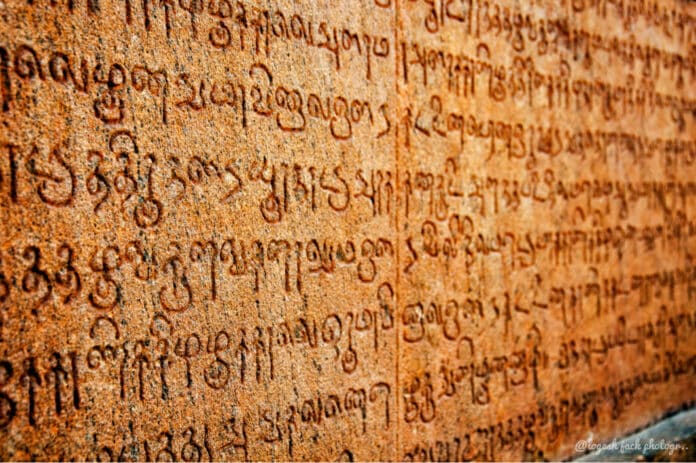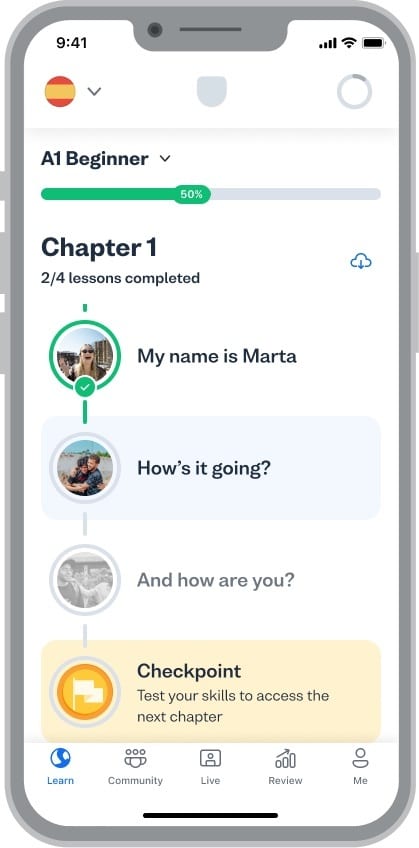Home » Top 10 oldest languages in the world

If you want to learn one of the oldest languages in the world in 2022, you’d be wise to choose one of the oldest languages still spoken today.
Usefulness combined with a rich linguistic history?
Sounds ideal.
We’ve done our research and compiled what we believe to be 10 of the oldest languages in the world still in use today.
These elegant and ancient languages have long histories. They’ve changed and adapted over the centuries and millennia. And today, you can learn them and still find companions to make conversation with.
How cool is that?
Of course, there’s a lot we don’t know when you go back thousands of years. It’s true that you could make an argument for the inclusion of many other old and wonderful languages, but these are the ones we were able to find the most convincing evidence for as being both ancient and in use in some form or another today.
And so, with that, we give you 10 of the oldest languages in the world that are still spoken today.
The first known language ever was a proto-language on the African continent, and the first known proto-writing system was created in Nigeria.
So, it is perhaps no surprise that the oldest language on this list is also from and used in Africa – Egyptian. The first known complete sentence in Ancient Egyptian was recorded in roughly 2690 BCE, making it over 4700 years old.
While the Egyptian language by and large hasn’t been spoken by regular people since the nineteenth century (which is, sadly, why you don’t see a lot of hieroglyph keyboards for sale, as cool as that would be), it is technically still in use today.
The language descended from Ancient Egyptian that survives today is called Coptic, and it’s primarily used as the liturgical language of the Coptic Orthodox Church of Alexandria and the Coptic Catholic Church.
But hey, that’s pretty remarkable, especially after over 4500 years!
With its oldest texts dating back to around 1500 BCE, Sanskrit is probably the second oldest language in the world still being used today.
Like Coptic, Sanskrit is largely used in religious texts and ceremonies that persist today, with a place in Buddhism, Hinduism, and Jainism.
However, Sanskrit words and phrases are also frequently used by bureaucratic institutions – from missile names to school mottos – in India, Indonesia, Sri Lanka, Nepal, and other parts of South and Southeast Asia.
Interestingly, several thousand people report Sanskrit as their first language on India’s census each time it’s performed, though it’s believed no one speaks it as their first language today.
Why?
Researchers think some individuals list it as a sort of aspirational mother tongue.
Regardless of whether or not anyone’s actually speaking Sanskrit at home, there are certainly people who speak and read it as a second language in India and beyond, with entire universities dedicated to the study of Sanskrit.
And, as well as its use in prayer and meditation, it’s also in use in modern literature and music, and in conversation through loan words that have made their way into other languages around the world.
Moving forward just a hair in time, Greek is probably the oldest language still spoken as a primary, day-to-day language. While Modern Greek has evolved significantly from the Greek spoken in ancient times, the language of Greece today is a definitive descendant of the language of Homer and those who came before him… way before him.
The works of Homer are believed to have been composed between the seventh and eighth centuries BC.
Mycenaean Greek, the first attested (meaning, essentially, confirmed by linguists) iteration of Greek first appeared in 1450 BCE, 700 or so years before The Odyssey hit the scene. And today, contemporary Greek has approximately 13.5 million native speakers. Not too shabby after almost 3,500 years.
Another competitor for both oldest written language and oldest spoken language still in use today, Chinese is definitely both useful and backed by a long, rich history.
The first attested Old Chinese goes back to a set of inscriptions on oracle bones dated to roughly 1250 BCE.
Of course, there are many different language varieties and dialects in China today, so Chinese is a fairly broad term here – but many of today’s most used varieties (including Mandarin and Cantonese) fall within the Sino-Tibetan language family and are descended from the Old Chinese we’re referencing here!
When it comes to languages that are both ancient and useful, Chinese has to take the top of the list.
After all, Mandarin is the single most spoken language in the world today, with over 1.1 billion speakers. So if you’re looking to learn one of the oldest languages in the world still spoken today, you can’t go wrong if you learn Chinese.

Learn to speak an ancient language with modern practicality – like Chinese, Italian, or Arabic – on Busuu today.
In the quest for the oldest living language in the world, those not versed in the culture of Iran, Iraq, Lebanon, Syria, and Turkey might not expect Aramaic to appear on the list. However, Aramaic is quite ancient – the Aramaic alphabet was the precursor to both the Hebrew and Arabic alphabets.
But Aramaic, the language spoken by Arameans in ancient Syria and first attested in 1100 BC, has survived well into its 4th millennium. In fact, among these oldest languages in use today, it’s actually more lively of a living language than Sanskrit or Coptic. There are somewhere between 800,000 and 1,000,000 speakers of Neo-Aramaic languages in the world today. Who knew?
Speaking of the Hebrew alphabet, Hebrew was first attested only around 100 years after Aramaic, in 1000 BCE, making it another member of the ‘Oldest Language Still in Use’ Club.
Hebrew is, perhaps, unique on this list as a language that ceased to be a common mother tongue for some time, but was eventually successfully revived as a living language.
Hebrew was primarily used for religious texts, correspondence and communications between Jewish people who otherwise did not share a language from around the second century CE onwards.
It was revived as a spoken language by activists in the nineteenth century, starting in Germany. Today, there are over nine million speakers of modern Hebrew, about five million of whom speak it as a first language. Pretty cool!
While not the earliest known language in the Indo-Iranian language family, Farsi is the longest surviving spoken language of the Iranian family of languages. It takes its roots from Old Persian, which was first attested somewhere between 522 and 486 BCE.
According to the Department of Asian and Middle Eastern Studies at UNC Chapel Hill,
, there are roughly 70 million native Farsi speakers and 110 million speakers of the language total around the world today. There are communities of native Farsi speakers in Iran still today, but also in Afghanistan, Azerbaijan, Iraq, Russia, Tajikistan, Turkmenistan and Uzbekistan – as well as in Persian diasporic communities worldwide.
One of the official languages of Singapore, Sri Lanka, and the state of Tamil Nadu in southern India, Tamil is another wonderful language with a long and storied history.
It’s frequently cited as the language in India – if not the world – that has the most direct line back to its classical roots, in terms of how it has evolved over time.
And, with over 75 million native speakers, it’s certainly no exaggeration to say it remains in use as a common first language.
When you speak to Tamil enthusiasts, they may tell you it’s the oldest language in the world, and in some ways that might be true!
According to Russian Linguist Dr. Mikhail S. Andronov, Tamil descended from Proto-Dravidian, a proto-language reconstruction, which may have been in use as far back as the fourth millennium BCE – and which, if true, would make it the oldest language on this list! But it’s a little hard to prove. What we do know is that Old Tamil can be attested back to 300 BC. Which is still nothing to scoff at.
Tamil, oldest language or not, is certainly ancient. And a handy language to speak, if you’re thinking about dropping by the southern part of India, Sri Lanka, or Singapore!
No top 10 list about the oldest language in the world still spoken today would be complete without Korean, another language that dates back thousands of years. Spoken as the primary language in both North and South Korea, there are at least 77 million native speakers of Korean today.
There is some dispute about when exactly Proto-Koreanic language transitioned into Old Korean, but it’s clear that by the Silla state, established in 57 BCE, there was a Koreanic language or proto-language in use.
Interestingly, the older Korean writing system known as Hanja, based on Chinese characters, can be dated back to 400 BC and the Gojoseon period when Ye-Maek, an extinct Koreanic language from Manchuria and eastern Korea, was the common language. The Hangul phonetic characters unique to the Korean language today weren’t developed until the fifteenth century – they’re practically new!
Last, but certainly not least, we have Italian. As you may have gathered, it can be tough to determine the oldest language still in use without getting into the lineage of a language – where do you draw the line between historical and modern languages, if one begat the other?
Early Latin was used in the Roman Republic, certainly by 75 BCE, but possibly much earlier (the Roman Republic was formed in 509 BC). After some deliberation, Italian made its way on to the list as the most direct modern descendant of Latin – though any of the Romance languages could have made it, really.
So why pick Italian? Because Italian remains the language of Rome, and descended directly from the Vulgar Latin of the Roman Empire through Italy in the Middle Ages. Today, Italian has about 67 million native speakers in the EU and beyond, and many more choose to learn Italian for its beauty.
Before we wrap things up, there is one special mention: the Arabic language. If you think Italian’s a bit of a stretch, then Arabic might be your tenth language on this list of oldest languages in the world. Old Arabic can be traced back to the first century CE, and its modern descendant is spoken by over 300 million people. That makes it terrifically handy to learn Arabic, both for history buffs and modern travelers.
And there you have it! Those are some of the 10 oldest languages still spoken in the world today.
Of course, when you’re talking about 2000 BCE, some of the accounts get a little murky, so if you know something we’ve missed, feel free to weigh in in the comments!
To borrow a phrase from George & Ira Gershwin, the Rockies may crumble, Gibraltar may tumble, they’re only made of clay – but it seems these languages are here to stay.
And you can get started learning some of them on Busuu for free today!
Get started on learning a new language – or a very old one – on Busuu today.
We think you might also like…